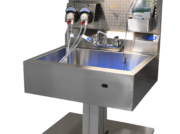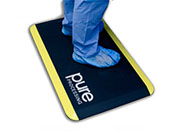
Ergonomic guidance for SPD injury prevention and productivity
Incorporating ergonomics into your central sterile processing or GI department is essential to increasing employee efficiency, satisfaction, and safety. It may be difficult to pinpoint every ergonomic issue in your department, but several organizations have developed guidelines which can help you identify potential areas for improvement and how to implement enhancements for your staff members.
1. Occupational Safety and Health Administration (OSHA)
OSHA offers a possible solution for consistent bending by “placing an object such as a plastic basin in the bottom of the sink to raise the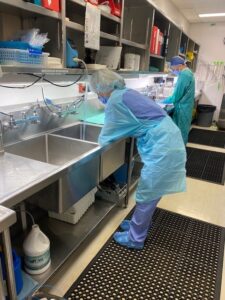 surface up while washing items in the sink.” Technicians often find themselves reaching into deep sink basins to properly clean instruments in decontamination. While deep sinks may be required for heavy soaking or larger trays, they are not conducive for most manual cleaning tasks. Prolonged bending can lead to lower back, shoulder, and neck pain over time, creating more serious issues in the future. Incorporating a PureStation™ Sink Insert into a deep sink basin to raise the working level and lessen bending can save your technicians from unnecessary pain and meet the necessary safety guidelines.
surface up while washing items in the sink.” Technicians often find themselves reaching into deep sink basins to properly clean instruments in decontamination. While deep sinks may be required for heavy soaking or larger trays, they are not conducive for most manual cleaning tasks. Prolonged bending can lead to lower back, shoulder, and neck pain over time, creating more serious issues in the future. Incorporating a PureStation™ Sink Insert into a deep sink basin to raise the working level and lessen bending can save your technicians from unnecessary pain and meet the necessary safety guidelines.
OSHA also suggests using “height-adjustable work surfaces or lift tables to minimize head tilt.” Expecting all employees of varying heights to use the same worktables and reprocessing sinks positioned at the same height can create an ergonomic hazard in departments. The use of height-adjustable workstations and reprocessing sinks can reduce the risk of back injuries in technicians and nurses by allowing the user to adjust the height to their most optimal level.
When evaluating height-adjustable equipment, it is also important to assess another OSHA requirement, “Redesigning workstations so packaging and equipment can be reached while maintaining the elbows close to the body.” Reprocessing sinks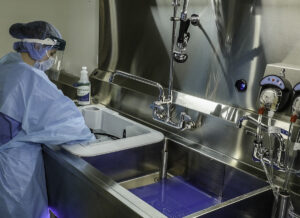 and assembly tables often come with many accessories and mounted items such as monitors, shelves, or powered equipment. These accessories, used often and throughout reprocessing tasks, should be positioned on equipment to reduce reaching over shoulder height, and avoid flexion pain for employees. Height-adjustable equipment that allows the entire station, including their many accessories, to adjust to the user’s most optimal height should be considered when designing tables and sinks.
and assembly tables often come with many accessories and mounted items such as monitors, shelves, or powered equipment. These accessories, used often and throughout reprocessing tasks, should be positioned on equipment to reduce reaching over shoulder height, and avoid flexion pain for employees. Height-adjustable equipment that allows the entire station, including their many accessories, to adjust to the user’s most optimal height should be considered when designing tables and sinks.
PureSteel™ Reprocessing Sinks and Ergonomic WorkStations are all height-adjustable so users can vertically adjust their stations to adapt to their ideal working height. PureSteel™ stations also feature back wall organizational pegboards which also adjust with the unit, ensuring the entire station is positioned properly for the user.
View a complete list of OSHA recommended solutions for more details.
2. HSPA
HSPA identifies several ergonomic concerns that any department could be facing. One of the identified stressors is frequent repetition. Syringe flushing cannulated items requires a lot of force and repetition, leading to carpal tunnel syndrome and other musculoskeletal disorders. Training employees to recognize the signs and symptoms of injuries, report potential problems, and recognize tasks that can cause ergonomic stressors can help identify corrective actions to address issues.
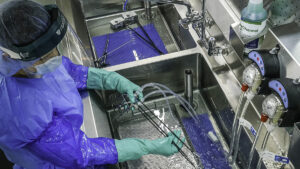
The FlexiPump™ Independent Flushing System can provide hands-free, ergonomic-friendly lumen flushing that is safe for technicians and nurses, enhances manual cleaning of cannulated devices, and meets ANSI/AAMI ST79:2017 and instructions for use (IFU) requirements. Users can attach up to three lumened devices at once to each FlexiPump system to meet the copious flushing IFUs for each device without the frequent repetition and force of a syringe or spray gun.
3. ANSI/AAMI ST91:2021
ANSI/AAMI ST91: 2021 suggest:
“Anti-fatigue mats should be:
o used in areas where prolonged standing is required; and
o constructed of materials capable of withstanding frequent cleaning”
Technicians can endure hours of prolonged standing at sink basins and prep and pack tables. The use of anti-fatigue mats increases employee comfort and removes unnecessary fatigue and discomfort from standing on hard department floors.
When determining which anti-fatigue mats to use in your department, consider:
- Whether the mat provides anti-fatigue benefits. Many mats reduce the risk of slipping, but don’t actually relieve pain or make standing more comfortable.
- The ability for the mats to withstand robust and heavy cleaning.
- Sizes of mats appropriate for the space in which they will be worked.
- Mats which can be used in both decontamination and assembly areas, which makes cleaning and reordering easier and more consistent.
GelPro™ Eco-Pro Anti-Fatigue Mats are a cart-washer safe mat choice for reprocessing departments. They are a one-piece construction made from renewable, plant-based material, making them an environmentally friendly, sustainable choice for departments that replace mats often or on routine schedules.
By understanding these ergonomic guidelines, managers and staff members can help make immediate improvements in their departments or begin planning for larger scale enhancements in the design of their equipment.
For more solutions to ergonomic issues in sterile processing, endoscopy, or operating rooms, check out our newly updated product catalog.
References:
- ANSI/AAMI ST91: 2021: ANSI AAMI ST91 | Flexible and semi-rigid endoscope processing | AAMI
- ANSI/AAMI ST79: 2017: ANSI AAMI ST79 2017 | AAMI





